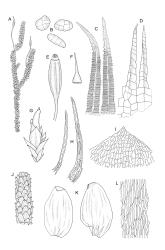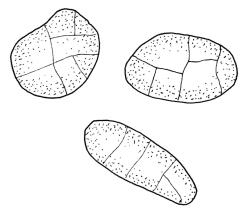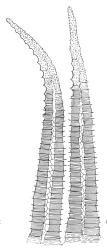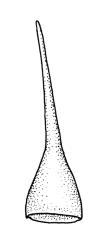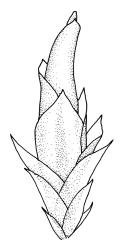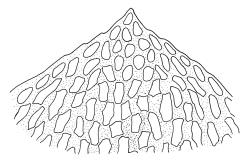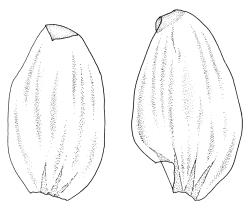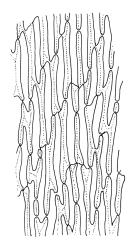- ≡ Leskea ericoides Hook., Musci Exot. 1, pl. 28 (1818)
Plants bright green or yellow- to brown-green, robust, forming loose and pendent wefts. Primary stems well developed. Secondary stems usually ± pendulous, curving upwards at apex, (25–)40–80(–120) mm, sparsely forked or simple, in cross-section oval or round, lacking a central strand. Shoots cylindric, not tapered at apices, with smooth, red-brown rhizoids occasionally produced in dense fascicles near apices or at branching points. Leaves of secondary stems densely imbricate, erect-spreading, arranged in several well-defined spiral ranks, broadly ovate or broadly elliptic, strongly plicate below and with some plications extending nearly to the leaf apex, clasping and ± auriculate at base, obtuse and strongly reflexed at apex, symmetric and concave, plane and mostly weakly crenulate at upper margins, often weakly toothed at extreme base, c. 3.0–3.2 ×1.5–1.7 mm and c. 2:1; those near the stem apex not differentiated; mid laminal cells linear, mostly 30–45 × c. 5–6 µm, strongly porose, smooth, those at apex shorter; cells at insertion forming a distinct band across the leaf base; alar cells not differentiated. Costa absent (illustration here is misleading). Paraphyllia absent. Gemmae absent.
Phyllodioicous. Perichaetia inconspicuous, scattered on secondary stems, apparently lacking paraphyses, with inner leaves c. 1 mm, broadly ovate, acute and non-reflexed at apex, often ± asymmetric; enlarging after fertilisation and becoming broadly elliptic, tubular, and obtuse and clasping the seta for >⅓ of its length. Male plants dwarf, epiphytic on leaves of female plants. Setae (5–)8–10(–13) mm, red-brown; capsules erect, symmetric, cylindric, strongly ribbed, red-brown, 2.5–3.0 mm, with virtually no neck; exothecial cells rounded or somewhat polygonal; annulus present, persistent, of 3–4 rows of firm-walled cells; operculum c. 2.5 mm and rostrate from a conic base, often ± equal the capsule. Exostome teeth c. 500–700 µm, not shouldered, furrowed and bordered, transversely striate and finely papillose on outer surface, densely trabeculate but otherwise nearly smooth on inner surface; endostome arising from a basal membrane c. 200 µm high, with long, strongly keeled segments nearly the length of the teeth; cilia absent. Calyptra narrow, enclosing the entire capsule. Spores multicellular (to 15-celled or more) and green, extremely variable in shape and size, up to c. 140 × 60 µm.
Hooker 1818, pl. 28; Brotherus 1925, fig. 512 g–n; Sainsbury 1955, pl. 53, fig. 2; Beever et al. 1992, fig. 55; Malcolm & Malcolm 2003, p. 14.
There are few species in the N.Z. flora with which Cladomnion could be confused. In the Ptychomniaceae, Hampeella alaris has similarly reflexed leaf tips, but Cladomnion is quite readily differentiated from it by having much larger and broader leaves that are strongly plicate, by the absence of gemmae, and other features including those of the peristome and spores. Ptychomnion densifolium is a more robust plant, growing terrestrially rather than epiphytically, and with the upper half of the leaf (rather than merely the apex) strongly squarrose.
NI: N Auckland including offshore islands (LB, GB), S Auckland, Gisborne, Hawke’s Bay (Makatoka, Te Āpiti, Ongaonga), Taranaki, Wellington; SI: Nelson, Marlborough (D’Urville I., Kenepuru, Mt Stokes, Mt Robertson, Pelorus Bridge Scenic Reserve), Westland, Otago (Leith Valley, Pine Hill, near Papatōwai, Humboldt River), Southland; St; Ch; A; Sol.
Endemic.
Cladomnion ericoides is a frequent forest species in wetter parts of the main islands. It occurs most frequently on twigs and small branches of understorey trees and shrubs, and is a common species in the forest canopy in wet forest. It occurs less frequently on the trunks and larger branches of a wide variety of tree species. The best developed populations are often associated with forest margins. A large number of herbarium collections are from branches fallen from the forest canopy, and these account for the bulk of, if not all, records of it growing on the forest floor. It is extremely catholic in terms of its host species (occurring on at least 15 genera). It occasionally grows on tree bases and stumps. Occasional herbarium records indicate its occurrence on rock (e.g., on lava at 1200 m at Te Mari on Mt Tongariro, Wellington L.D.). On the North I. it ranges from 90 m (Mangamuka Gorge, N Auckland L.D.) to at least 1040 m (Waipunga River, S Auckland L.D.) as an epiphyte and occasionally higher on rock (1200 m on lava at Te Mari Hill, Wellington L.D.). On the South I. it ranges from near sea level (several localities including Madmans Creek, Nelson L.D., and Pourākino River, Southland L.D.) to at least 1070 m (Paparoa Range, Nelson L.D.). Frequent bryophyte associates include Dicnemon spp., Glyphothecium sciuroides, Leptostomum spp., Mesotus celatus, Macromitrium longipes, Papillaria flavolimbata, Weymouthia cochlearifolia, W. mollis, and Lepicolea scolopendra.
Most of the Hawke’s Bay L.D. localities are based on pre-1900 collections (including several collections made in the 1880s by W. Colenso) and the plant has been rarely collected there in recent decades, certainly reflecting deforestation of parts of this L.D. It is a relatively rare plant in Marlborough and Otago L.D. (with many of the Otago collections from the relatively wet hills close to Dunedin). It has not been recorded from Canterbury L.D. It is known from the Auckland Is from only one collection (WELT M003546) made by Colleen Black in 1973.
Cladomnion ericoides is a distinctive and beautiful moss and, once recognised, it is unlikely to be confused with any other species in the N.Z. flora. It is most commonly observed forming pendent mats from branches and twigs. The lustrous, strongly plicate and apically reflexed leaves and the abruptly upwardly swept shoot apices make this species easily recognisable. The description of Beever et al. (1992, p. 114) of the branches of Cladomnion as "rope-like" due to the usually regularly spiralled ranks of leaves is apt and calls to mind some of the "funiculate" species of Macromitrium.
Both unfertilised perichaetia and dwarf epiphyllic male plants are inconspicuous and often difficult to find. Brotherus (1925, fig. 512, n) illustrated paired endostomal cilia for this species, but these have not been observed, despite numerous dissections. His illustration may be an error and Sainsbury’s (1955, p. 341) description of the endostome was probably unduly influenced by Brotherus’s illustration. The usual multicellular spores of this species are probably the result of precocious (in situ) germination giving rise to an endosporic protonema; a few single-celled spores can usually be observed in dissected capsules.




